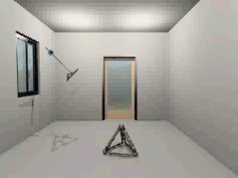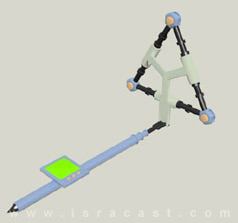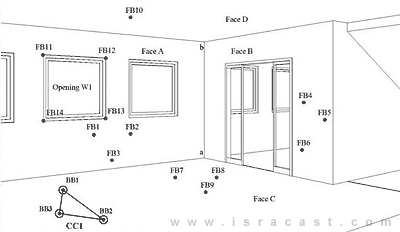The Israeli start-up company EZ2CAD has developed a cheap system that allows you to make a XNUMXD model of a room
Simulation of the operation of the QuickSurveyor system
By: Ido Gnot

The Israeli start-up company EZ2CAD has developed a cheap system that makes it possible to make a XNUMXD model of a room. This is according to the Israeli news site in English ISRACAST. The system makes it possible to perform precise computerized measurements inside buildings. It allows a single operator to measure a room and create a CAD model in real time, which can be used for further planning of the interior structure. The system works with ultrasound and transmits radio waves (RF) between the base station and the mobile unit. In this way, the new system reduces the limitations of line of sight or "open sky" required for the existing (GPS-based) survey systems, but still allows the system to maintain a lower price level than the existing systems.
Reviewing is an ancient profession. The Ancient Egyptians The Egyptians used ropes with knots marking known units of distance just as we use a ruler today to measure distances for construction work and other applications. More advanced measuring devices have been developed over the years and in the last few decades the pace of developments in the devices used in the world of geodesy has increased. The laser distance measuring device and the GPS system helped dramatically improve the accuracy of the devices, and they led to ease of use and reduced prices. Despite these improvements, both the GPS-based devices (trade name RTK-GPS) and the Total Station devices still suffer from limitations. RTK-GPS devices require "open skies" to receive the satellite signals and this limits the performance of their measurements inside buildings, in areas with dense construction, forests, etc. TS devices are limited in line of sight and visibility conditions in the area. All established systems require the existence of a "measuring stick" and the need to hold it vertically. The existing systems are also expensive and start at tens of thousands of dollars per unit, and therefore are mainly used by professional surveyors.
QS Rover
 To overcome these limitations, a team of professional surveyors and engineers from Israel developed a new device known as QuickSurveyor. The new system consists of two units, a base station and a lightweight mobile component known as a rover. The base station is a 50 cm high metal pyramid that includes tiny receivers and transmitters in both the radio and ultra-satand fields. The rover is a mobile unit in the form of a 3 meter long telescopic pole, which can be extended up to XNUMX meters to measure in places where the ceiling is high, and other places where access is not easy. The rod unit includes three sensors that form a triangle between them and also a laser distance measuring device to extend the range. The rover unit can also include a laptop that shows the progress of the measurement in real time. Alternatively, the rover can transmit the data to a nearby laptop.
To overcome these limitations, a team of professional surveyors and engineers from Israel developed a new device known as QuickSurveyor. The new system consists of two units, a base station and a lightweight mobile component known as a rover. The base station is a 50 cm high metal pyramid that includes tiny receivers and transmitters in both the radio and ultra-satand fields. The rover is a mobile unit in the form of a 3 meter long telescopic pole, which can be extended up to XNUMX meters to measure in places where the ceiling is high, and other places where access is not easy. The rod unit includes three sensors that form a triangle between them and also a laser distance measuring device to extend the range. The rover unit can also include a laptop that shows the progress of the measurement in real time. Alternatively, the rover can transmit the data to a nearby laptop.
EZ2CAD, the developer of the QuickSurveyor system, is in an advanced stage of building a working prototype. The company's consultant, Benny Marcus told the Isracast website that the market for review devices is estimated at over 3 billion dollars per year and may grow to over 5 billion in 2008. Marcus explains that QuickSurveyor can also be used as an inexpensive replacement for existing systems and can also complement and improve the performance of existing systems. Because of this, it will be intended not only for professional surveyors but also for architects, building contractors, interior designers and appraisers who have not used the existing equipment due to its price and the complexity of its use. The price of the system is expected to range between 3000 and 10,000 dollars (significantly below the other products mentioned).
EZ2CAD is currently looking for investors for the first stage of R&D as well as for the later stages of commercial product production. The company plans to market its innovative systems in about two years.

